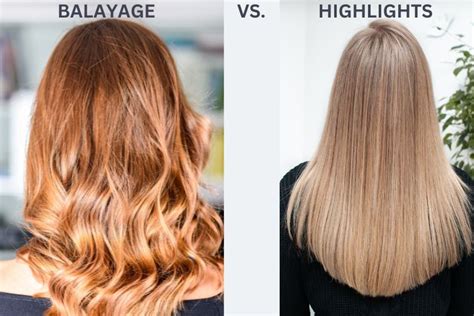Introduction

Balayage and highlighting have become the most popular hair coloring techniques, each offering distinct advantages and looks. In this article, we delve into the differences, benefits, and drawbacks of balayage and highlights to help you make an informed decision for your next hair transformation.
What is Balayage?
Balayage is a freehand painting technique where color is applied to the hair in sweeping, horizontal strokes. This method creates subtle, natural-looking highlights that blend seamlessly with the base color. Balayage is often used to create a sun-kissed effect or to add depth and dimension to hair.
What are Highlights?
Highlighting involves using foils or a cap to isolate individual strands of hair, which are then bleached or colored to create contrast with the base color. This technique offers more precise and controlled placement of highlights, allowing for brighter and bolder looks.
Key Differences
- Application Technique: Balayage is freehand, while highlights are sectioned and controlled.
- Highlight Frequency: Balayage typically requires less frequent touch-ups, while highlights may need to be repeated more often to maintain contrast.
- Blended Effect: Balayage creates a more blended and natural look, while highlights provide a more defined contrast.
- Maintenance: Balayage is generally lower-maintenance than highlights, as the blending helps disguise root growth.
- Cost: Balayage tends to be more expensive than highlights, due to the time and skill required.
Benefits of Balayage
- Natural-Looking: Creates a subtle, sun-kissed effect that blends seamlessly with the base color.
- Low-Maintenance: Requires less frequent touch-ups, as root growth is less noticeable.
- Adds Depth: Enhances hair’s dimension and interest without creating harsh lines.
- Suitable for All Hair Types: Can be customized to flat or textured hair to achieve varying levels of blending.
Benefits of Highlights
- Precise Placement: Allows for controlled highlighting of specific areas to enhance facial features or create contrast.
- Bold Statements: Creates brighter, bolder highlights that stand out against the base color.
- Corrects Color: Can fix uneven color or unwanted warmth by adding fresh highlights.
- Variety of Tones: Offers a wide range of highlight shades to match any base color and desired look.
Drawbacks of Balayage
- Time-Consuming: Can take longer than highlights, especially for thicker or longer hair.
- Skill Dependent: Requires a skilled colorist to achieve the desired blend and seamless transition.
- Less Control: The freehand application can result in less precise highlighting compared to foils or a cap.
- May Not Suit All Faces: Certain facial shapes or skin tones may benefit more from traditional highlights.
Drawbacks of Highlights
- High-Maintenance: Requires frequent touch-ups to maintain contrast and prevent root growth from becoming visible.
- Potential Damage: Bleaching or coloring can damage hair, especially if not done professionally.
- Can Look Unnatural: Foils or a cap may create harsh lines if not properly applied.
- Not Suitable for All Hair Types: May not be ideal for very fine or damaged hair that can’t withstand the bleaching process.
Comparison Table
| Feature | Balayage | Highlights |
|---|---|---|
| Application Technique | Freehand painting | Foils or cap |
| Highlight Frequency | Less frequent | More frequent |
| Blended Effect | Yes, natural | No, defined |
| Maintenance | Lower-maintenance | Higher-maintenance |
| Cost | More expensive | Less expensive |
Tips and Tricks
- Consider your Hair Type: Balayage is suitable for all hair types, while highlights may be better for thicker hair.
- Determine the Desired Effect: Balayage provides a blended, natural look, while highlights offer more contrast and boldness.
- Consult a Professional: A skilled colorist can help you achieve the best results and avoid common mistakes.
- Use Hair Care Products: Protect colored hair with heat protectants, color-safe shampoos, and conditioning treatments to maintain its vibrancy.
- Avoid Over-Washing: Limit hair washing to 2-3 times a week to preserve color and prevent fading.
Common Mistakes to Avoid
- Over-Bleaching: Bleaching hair too frequently can damage it and result in brassy tones.
- Applying Too Much Heat: Using excessive heat with styling tools can also damage colored hair and fade its vibrancy.
- Incorrect Sectioning: Foils or a cap should be sectioned properly to prevent uneven or unblended highlights.
- Overlapping: Overlapping foils or sections can result in darker, more visible lines.
- Choosing the Wrong Color: Highlight shades should complement the base color and be appropriate for your skin tone.
Conclusion
Understanding the key similarities and differences between balayage and highlights is crucial for selecting the best hair coloring technique for your individual needs and preferences. Both methods offer unique benefits, but ultimately, the right choice depends on the desired effect, hair type, and level of maintenance you’re willing to commit to. By carefully considering the information presented in this article, you can confidently make an informed decision for a stunning and personalized hair transformation.
